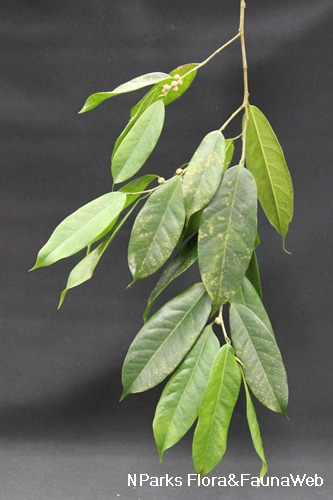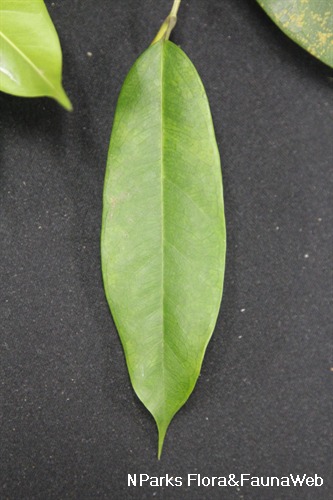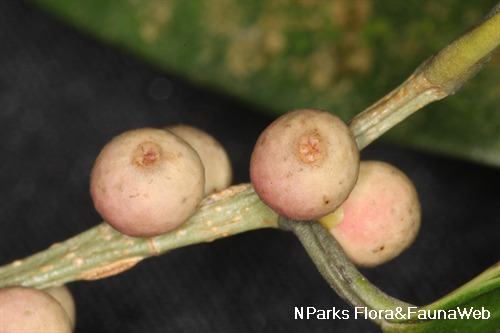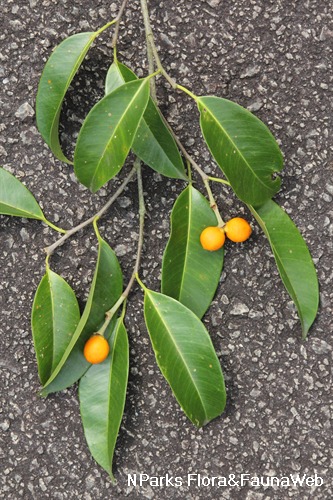
Name
Classifications and Characteristics
| Plant Division | Angiosperms (Flowering Seed Plants) |
|---|---|
| Plant Growth Form | Tree (Small (6m-15m)) |
| Lifespan (in Singapore) | Perennial |
| Mode of Nutrition | Autotrophic |
| Plant Shape | Weeping / Pendulous, Irregular |
Biogeography
| Native Distribution | Sumatra, Peninsular Malaysia, Singapore, Borneo, and Java |
|---|---|
| Native Habitat | Terrestrial (Primary Rainforest, Freshwater Swamp Forest) |
| Preferred Climate Zone | Tropical |
| Local Conservation Status | Native to Singapore (Critically Endangered (CR)) |
Description and Ethnobotany
| Growth Form | It is a strangling fig up to 10 m tall. |
|---|---|
| Foliage | Its spirally arranged, stalked leaves have thinly to thickly leathery leaf blades that are oblong to oval to lance-shaped, and 3–24 by 1–5.5 cm. |
| Flowers | The plant is monoecious. Its male, female and gall flowers are found within the same syconium (fig). The flowers are tiny and develop within the syconium (fig). |
| Fruit | Its syconia (figs) are solitary or in pairs, in the leaf axils, somewhat round, 3–6 mm across when dry, whitish to pinkish at maturity, and each with a perforated tip. |
| Habitat | It grows in lowland to hill forests, up to 1,000 m altitude. It occurs locally in Nee Soon swamp forest. |
| Associated Fauna | Its flowers are pollinated by fig wasps. The ripe fruits are eaten by frugivorous birds and mammals. |
| Cultivation | It can be propagated by seed, stem cutting and air-layering. |
| Etymology | Latin Ficus, the commercial edible fig (Ficus carica); Latin binnendijkii, commemorating S. Binnendijk, a 19th century horticulturist in the Bogor Botanic Gardens in Indonesia |
Fauna, Pollination and Dispersal
| Fauna Pollination Dispersal Associated Fauna | Bird-Attracting (Fruits) |
|---|---|
| Pollination Method(s) | Biotic (Fauna) (Insects (Ant, Beetle, Fly, Thrip, Wasp)) |
| Seed or Spore Dispersal | Biotic (Fauna) (Vertebrates (Bat), Vertebrates (Other Mammal)) |
Plant Care and Propagation
| Light Preference | Full Sun, Semi-Shade |
|---|---|
| Water Preference | Moderate Water |
| Plant Growth Rate | Moderate |
Foliar
| Foliage Retention | Evergreen |
|---|---|
| Mature Foliage Colour(s) | Green |
| Mature Foliage Texture(s) | Leathery |
| Foliar Type | Simple / Unifoliate |
| Foliar Arrangement Along Stem | Alternate |
| Foliar Attachment to Stem | Petiolate |
| Foliar Shape(s) | Non-Palm Foliage (Ovate, Lanceolate, Elliptical) |
| Foliar Venation | Pinnate / Net |
| Foliar Margin | Entire |
Non - Foliar and Storage
| Root Type | Underground, Aboveground |
|---|
Floral (Angiosperm)
| Flower & Plant Sexuality | Unisexual Flowers , Monoecious |
| Flower Grouping | Cluster / Inflorescence |
|---|
| Flower Location | Axillary |
| Inflorescence Type | Syconium |
Fruit, Seed and Spore
| Mature Fruit Colour(s) | Pink, White |
|---|---|
| Fruit Classification | Multiple Fruit |
| Fruit Type | Fleshy Fruit , Accessory / False Fruit (Pseudocarp) |
Image Repository
Others
| Master ID | 31198 |
|---|---|
| Species ID | 5592 |
| Flora Disclaimer | The information in this website has been compiled from reliable sources, such as reference works on medicinal plants. It is not a substitute for medical advice or treatment and NParks does not purport to provide any medical advice. Readers should always consult his/her physician before using or consuming a plant for medicinal purposes. |







.jpg)
